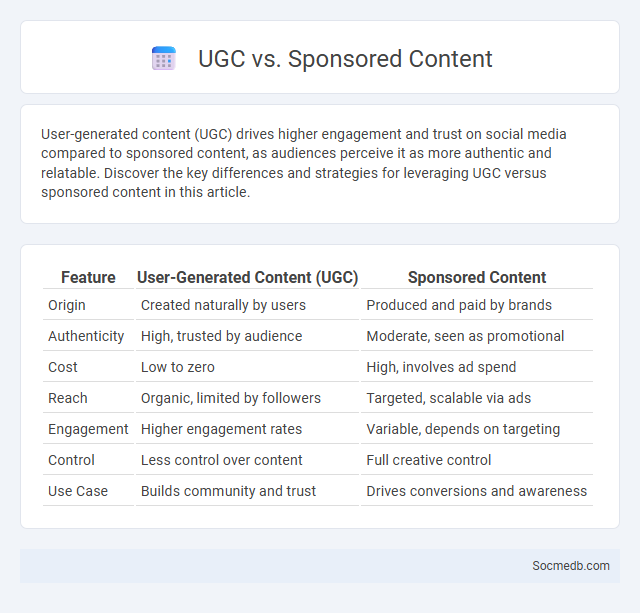
Photo illustration: UGC vs Sponsored Content
User-generated content (UGC) drives higher engagement and trust on social media compared to sponsored content, as audiences perceive it as more authentic and relatable. Discover the key differences and strategies for leveraging UGC versus sponsored content in this article.
Table of Comparison
| Feature | User-Generated Content (UGC) | Sponsored Content |
|---|---|---|
| Origin | Created naturally by users | Produced and paid by brands |
| Authenticity | High, trusted by audience | Moderate, seen as promotional |
| Cost | Low to zero | High, involves ad spend |
| Reach | Organic, limited by followers | Targeted, scalable via ads |
| Engagement | Higher engagement rates | Variable, depends on targeting |
| Control | Less control over content | Full creative control |
| Use Case | Builds community and trust | Drives conversions and awareness |
Introduction to UGC, Sponsored Content, and User-Generated Content
User-Generated Content (UGC) refers to any form of content, such as images, videos, reviews, or posts, created and shared by users rather than brands or companies. Sponsored content involves collaborations where brands pay influencers or content creators to promote products or services, often blending seamlessly with organic posts. Both UGC and sponsored content significantly influence social media marketing strategies by fostering authenticity and engagement, driving consumer trust and brand visibility.
Defining UGC: Characteristics and Examples
User-Generated Content (UGC) refers to any form of content, such as images, videos, reviews, or blog posts, created and shared by users rather than brands or professionals. UGC is characterized by authenticity, engagement, and trustworthiness, often driving higher conversion rates and organic reach on social media platforms like Instagram, TikTok, and Facebook. You can leverage UGC to enhance your brand's online presence by incorporating real customer experiences and testimonials.
What is Sponsored Content? Key Features and Examples
Sponsored content is a form of advertising where brands pay influencers or publishers to create posts that promote products or services while blending seamlessly with regular content. Key features include native integration, targeted audience reach, and often marked with labels like "Sponsored" or "Paid Partnership" to ensure transparency. Examples include Instagram influencer posts showcasing fashion brands, YouTube videos reviewing tech products, and blog articles featuring sponsored travel experiences.
User-Generated Content Explained
User-generated content (UGC) on social media refers to any form of content, such as photos, videos, reviews, or posts, created and shared by users rather than brands or marketers. This type of content enhances authenticity, builds trust, and drives higher engagement rates because it reflects genuine user experiences and opinions. Platforms like Instagram, TikTok, and Facebook leverage UGC to boost community interaction and influence purchasing decisions.
UGC vs User-Generated Content: Clearing the Confusion
User-Generated Content (UGC) refers to any form of content created and shared by consumers or users rather than brands, including reviews, photos, videos, and social media posts. UGC enhances brand authenticity and trust by showcasing real experiences, driving higher engagement and conversion rates compared to traditional branded content. Clarifying that UGC strictly involves user-originated material helps marketers effectively leverage this content type for impactful social media strategies.
Sponsored Content vs UGC: Main Differences
Sponsored content is professionally created advertisements funded by brands to promote specific products or services, designed to reach targeted audiences with controlled messaging. User-generated content (UGC) consists of authentic posts, reviews, and media produced voluntarily by consumers, reflecting genuine experiences and trustworthiness. Your marketing strategy should balance sponsored content's precision and UGC's credibility to maximize engagement and brand loyalty.
Benefits of UGC for Brands and Marketers
User-generated content (UGC) significantly boosts brand authenticity and trust, driving higher consumer engagement and conversion rates. It offers marketers cost-effective and diverse promotional materials that showcase real customer experiences and testimonials. Leveraging UGC enhances social proof and strengthens brand loyalty across platforms like Instagram, TikTok, and Facebook.
Advantages of Sponsored Content in Digital Marketing
Sponsored content in digital marketing enhances brand visibility by seamlessly integrating promotional messages within engaging and relevant material, fostering higher audience trust and engagement. This targeted approach leverages advanced data analytics and user behavior insights to deliver personalized content, increasing conversion rates and ROI. You benefit from expanded reach and authentic connections with potential customers, making sponsored content a powerful tool in your marketing strategy.
Choosing Between UGC and Sponsored Content: Factors to Consider
When choosing between user-generated content (UGC) and sponsored content for your social media strategy, consider factors like authenticity, engagement rates, and budget impact on ROI. UGC often builds trust and community because it originates from real users, while sponsored content offers greater control over branding and messaging. Understanding your target audience's preferences and campaign goals ensures you select the most effective content type to boost your social media presence.
Future Trends in UGC and Sponsored Content
Emerging trends in social media reveal a shift towards more authentic user-generated content (UGC) integrated seamlessly with sponsored posts, enhancing engagement and trust among audiences. Advanced AI tools are enabling creators to produce hyper-personalized content that resonates on a deeper level, driving higher conversion rates for brands. The rise of interactive formats like shoppable videos and augmented reality experiences is transforming sponsored content into immersive campaigns that blur the lines between advertisement and genuine consumer interaction.
 socmedb.com
socmedb.com